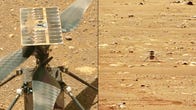Ingenuity snapped a photo of its own shadow during its second flight on April 22.
NASA/JPL-CaltechFirst, you get to Mars. Then, you hover. After that, you start to soar. Earlier this week, NASA's Ingenuity helicopter made history with the first powered, controlled flight on another planet. On Thursday, NASA said the little chopper had completed a more ambitious second flight.
NASA JPL tweeted, "Go big or go home!" when it confirmed the second flight and shared a black-and-white image Ingenuity snapped of its own shadow using a navigation camera.
Go big or go home! The #MarsHelicopter successfully completed its 2nd flight, capturing this image with its black-and-white navigation camera. It also reached new milestones of a higher altitude, a longer hover and lateral flying. pic.twitter.com/F3lwcV9kH2
— NASA JPL (@NASAJPL) April 22, 2021
The first flight on April 19 was a brief hovering exercise that saw the rotorcraft lift off from the Mars surface and reach a height of about 10 feet (3 meters). The Ingenuity team's second-flight plans had a goal of reaching 16 feet (5 meters) with a sideways move of 7 feet (2 meters). It was then set to hover in place and rotate while snapping pictures of its surroundings before returning to land at the center of its Martian airfield.
The helicopter handles all of the tasks autonomously. Commands are sent from Earth, but there is no real-time human control of the rotorcraft. We're still waiting on all the details of how the second flight went.
NASA is expecting color images from Ingenuity. We already have a sweet little preview video of the flight courtesy of the Perseverance rover.
#MarsHelicopter Flight #2 is in the books! I’ve captured its higher, bolder flight, and I’ll be sending back all my latest frames soon. Meanwhile, here's a quick preview, including takeoff and two turns. pic.twitter.com/MmNOuIQ8ly
— NASA's Perseverance Mars Rover (@NASAPersevere) April 22, 2021
Ingenuity -- which NASA has described as a high-risk, high-reward technology demonstration -- has shown that a small helicopter can function in the challenging conditions of Mars. The planet has a very thin atmosphere compared with Earth.
The small rotorcraft hitched a ride to Mars tucked into the belly of Perseverance, which is camped out at an overlook site to monitor the helicopter's exploits. There's still time left in the chopper's flight test window, so it's likely Ingenuity will fly again.
Follow CNET's 2021 Space Calendar to stay up to date with all the latest space news this year. You can even add it to your own Google Calendar.
https://ift.tt/3noypZT
Science

No comments:
Post a Comment